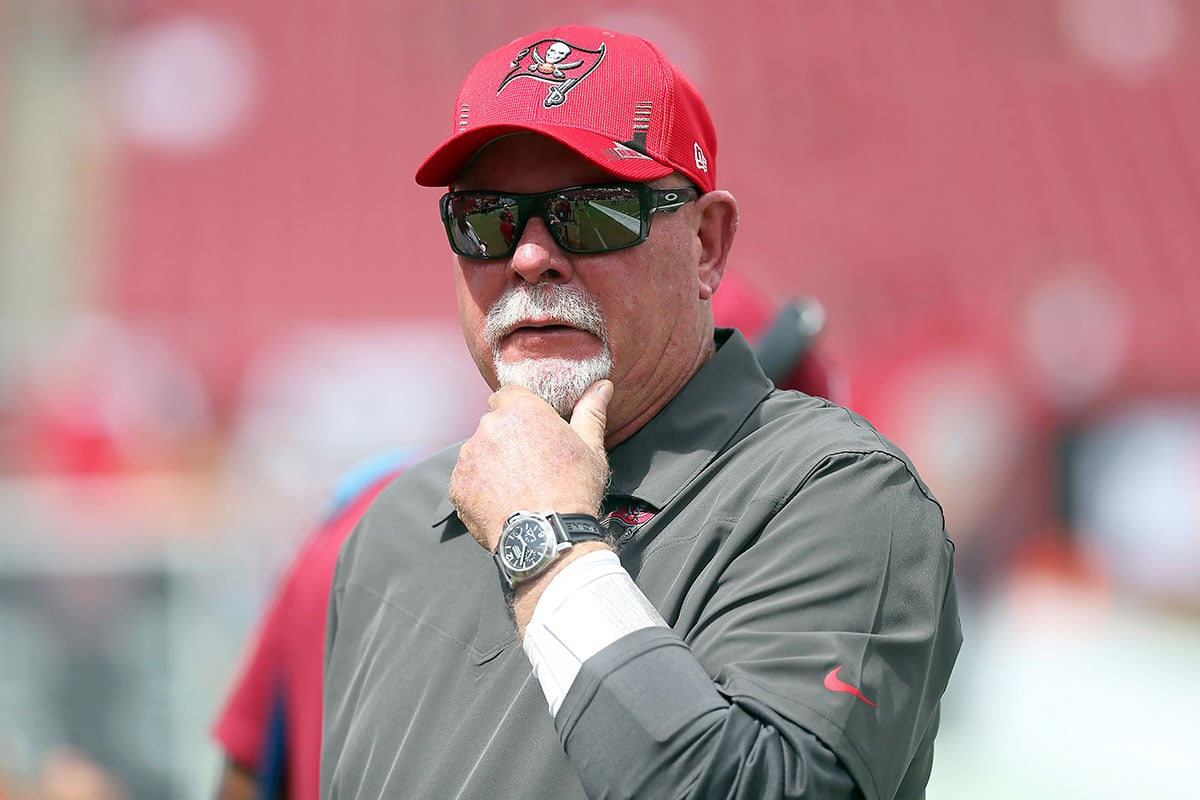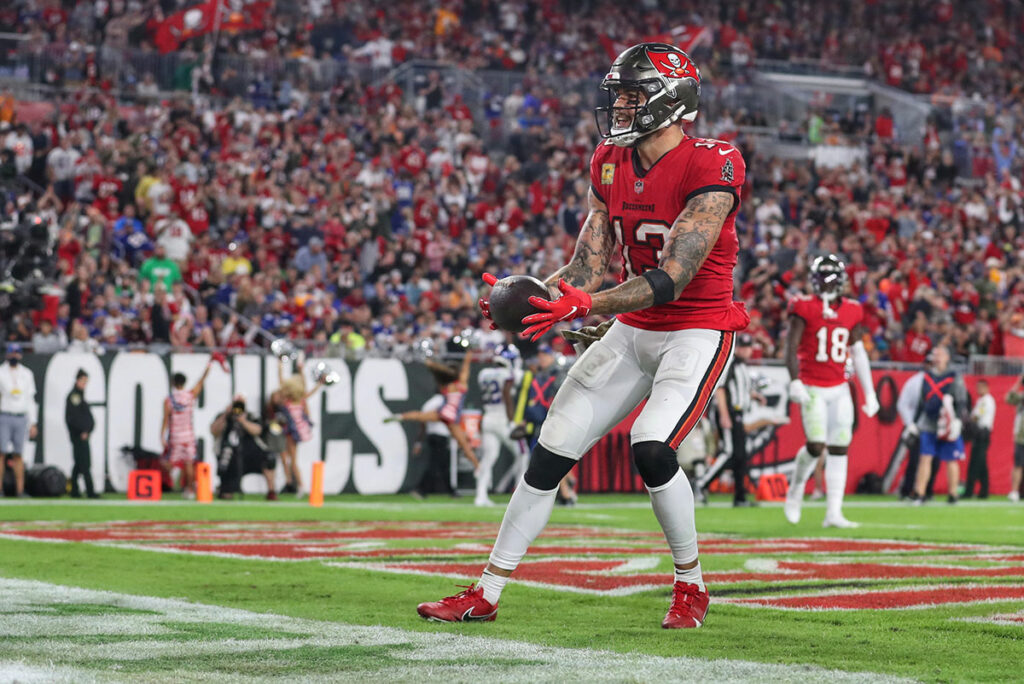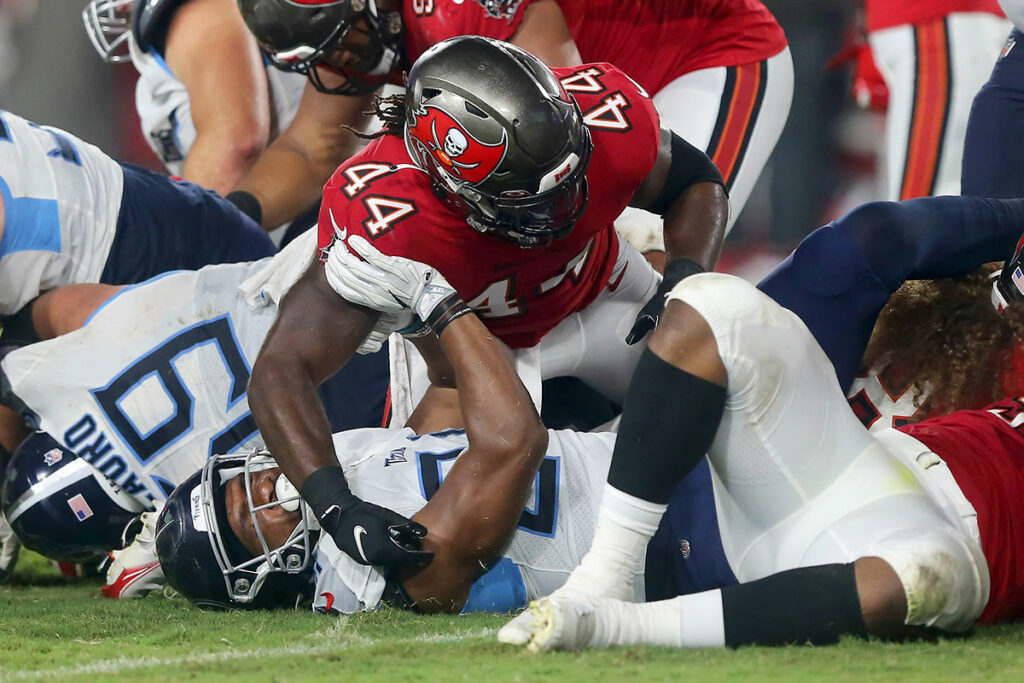Bruce Arians and Byron Leftwich are at a schematic crossroads with Chris Godwin done for the season. Godwin played what has always been the feature position in Arians’ offenses – the F/Z hybrid. He created mismatches in the run game, and the pass game revolved around creating space for him over the middle.
The coaches now have the unenviable task of deciding which strategy for their offense is the least bad, because whatever they choose will be worse than when they had Godwin.
Godwin was the operator of the Bucs’ strong side choice routes – something Arians’ offenses have always used more than most. Tom Brady trusted that he and Godwin would read the defense the same way mid-play.
The Rams’ two-high zone left Godwin one-on-one underneath reading safety Taylor Rapp (No. 24). Rapp walled off inside and Godwin took the easy win outside.
Brandon Jones (No. 29), the Dolphins’ hole player in cover 1, was determined to stop Godwin from getting open over the middle. Jones eyed and drifted towards Godwin, and Evans got wide open behind him.
#Bucs WR Chris Godwin had a breakout year in 2019, flourishing as the "Power Slot" in Bruce Arians' offense.
Godwin was not only a revelation in the passing game this season, but in the run game as well. Here's a compilation of Godwin showcasing his + blocking ability. pic.twitter.com/7wIeRHzgd9
— Nate Tice (@Nate_Tice) March 31, 2020
Godwin was also a run game cheat code. A blocking mismatch against defensive backs assigned to him, the Bucs occasionally used Godwin like a tight end to create additional gaps on the ground. He could play lead blocker if need be. No other receiver on the Bucs roster can fill that role.
Per Sharp Football Stats, at 74 percent, the Bucs were amongst league leaders in 11 personnel usage before Godwin’s injury. Once Mike Evans is back, I don’t see that changing. For the purposes of this piece, I’m going to assume Evans will return soon. Until then, the Bucs will play their tight ends more and plug Brown into Evans’ X position – like they did against the Panthers.
In an over-simplified broad strokes kind of way, I think there are three ways that the Bucs could deploy their personnel with Godwin out. And within each of these options exist a never-ending number of adjustable details. I’m going to add the caveat here that, while they are presented as mutually exclusive, Arians and Leftwich will likely blend elements from each of these strategies. We just don’t know how that blend will be portioned.
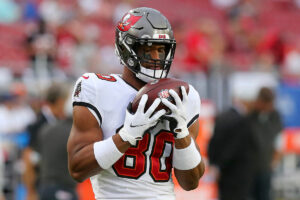
Bucs TE O.J. Howard – Photo by: Cliff Welch/PR
The first option is to spam 12 personnel. It’d be Evans, Brown, Rob Gronkowski, and a split between Cameron Brate and O.J. Howard. Brady would likely find himself working under center more – a deviation from the shotgun-heavy offense he previously captained. Defenses could match with base, meaning big bodies covering the Bucs’ tight ends in the pass game, or they could play nickel, meaning smaller players having to fight through tight end blocks in the run game. More YY wing formations, hard-nosed runs, and heavy play fakes. Early on, color commentators would inevitably draw comparisons to the Patriots of the early 10s when Gronk and Aaron Hernandez created matchup nightmares.
And then those comparisons would end. Quickly. Unfortunately, Brate and Howard are nowhere near the mismatch that Hernandez was in the second tight end spot. They’re not even the mismatches that they were in the past. Both Brate and Howard are arguably having the worst seasons of their careers!
For as much as Howard’s speed jumped off the screen early last season, he has been invisible this year. He ruptured an achilles tendon and returned to action in less than 12 months – the drop off was to be expected. It sucks, but the reality is that Howard is currently not scaring defenses as a receiver, and he’s worse than ever as a blocker.
Brate’s decline doesn’t have a clear explanation, nor has it been as stark. But he also wasn’t as good as a healthy Howard to begin with.
I’m not saying Howard and Brate are terrible. They’re both still decent depth pieces when Gronk’s your starter. However, becoming 12 personnel-heavy would require the biggest schematic overhaul of the three options, and the ends will only justify the means if Howard or Brate can play like their former selves.
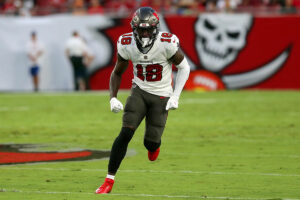
Bucs WR Tyler Johnson – Photo by: Cliff Welch/PR
Option two is to pretend Tyler Johnson is Chris Godwin. That’s it. Carry on as per usual, nothing to see here. It’s late in the season and this would schematically be the path of least resistance. But, for as much as Johnson has been advertised as “Baby Godwin” – perhaps more an exercise in hopeless optimism than earnest evaluation – he’s just…not. Sure, Johnson would minimize the loss in the run game. But the operative word there is ‘minimize’, not ‘eliminate’.
The Bucs often motioned Godwin in before runs to either even out the numbers or to create a numbers advantage. This would prompt a defensive back to come into the box – one who has no interest in fighting for position against Godwin. Johnson is a serviceable run blocker, but he’s not the plus weapon that Godwin was. To put Johnson in the premier position of this offense in an effort to preserve the run game would be to miss the forest for the trees.
Any changes have to consider the pass game first and foremost. One that, again, effectively revolves around getting the ball to this “power slot” player over the middle and underneath. It demands a player with agility, speed, and, given the number of option routes, high football IQ. Johnson lacks the quickness to separate, struggles against press, and is unproven as a high volume post-snap decision maker. He’s already made a troubling number of route-running mistakes this season. Like Brate and Howard, Johnson is a respectable depth piece. Though he is the natural substitute, Arians and Leftwich can’t treat Johnson as a plug-and-play for Godwin.
So that brings us to option three: feature AB. The 33 year old is still elite in every way as a pass catcher. And if there’s a sacrifice to be made in the Bucs’ offense, it should come at the expense of the run to preserve the pass, not the other way around.
Though he’s a quick, agile runner with high football IQ, Antonio Brown has always played predominately on the outside. His straight line speed and big play ability is plenty justification for that decision. But Brown has already played a higher share of his snaps from the slot in Tampa than he ever did in Pittsburgh. Since joining the Bucs, 21 percent of Brown’s snaps have come from the slot. That number routinely hovered around the low teens with the Steelers. For reference, Godwin played 61 percent of his snaps from the slot this season.
Brown can fill Godwin’s role as a pass catcher better than anyone else on the roster, but no Bucs coach has any interest in seeing him as a key blocker. He’s not the big-bodied slot receiver that Arians’ scheme has historically preferred, and the run game would therefore need tweaking. However, the offense has already shown it can make those adjustments.
One big change has been the Bucs’ shotgun usage. Before the Week 9 bye, the Bucs were in gun for 57 percent of their offensive snaps. From the bye through Week 15, that spiked to 70 percent. Prior to Godwin’s injury, the spread-to-run approach helped as the Bucs averaged -0.0045 EPA/rush from under center and 0.14 EPA/rush from gun (sample size wonkiness should be noted).
This has affected the Bucs’ play selection. Duo still runs the show, but since the bye, their power run usage has gone through the roof. They love one back power from gun, so this checks out. But Leftwich has leaned more on all runs that use a puller, not only power. These changes have come for good reason, too. Tampa Bay is ridiculously good at runs with a puller. They are by far their most efficient run types according to PFF. Oh, and here’s the cherry on top: these changes have led to less dependency on having a dominant blocking receiver. To be clear, the Bucs definitely still leveraged Godwin in the run game, but their adjustments laid the groundwork to change even more.
Moving Brown to the slot would be a full embrace of the spread, shotgun approach. It would mean less duo, more pin-and-pull, counter, and power. And given the efficacy of those runs thus far, replacing Godwin with AB role might not even come at the cost of the run game. Even if it does, the important part is minimizing the loss in the offense as a whole.
The Bucs offense runs into issues when it doesn’t have credible threats in the number one spots outside (the number one receiver is the receiver closest to the sideline on his side of the field). Defenses trust their players in single coverage to not lose deep when Johnson, Jaleon Darden, Gronkowski, Brate, or Howard are in the one spots. This gives defensive coordinators the freedom to play a single-high defense that prioritizes muddying up the middle with robbers/hole players. Alternatively, they can play two-high coverages, but have both safeties keying the inside receivers on the trips side. The strong safety supports any vertical routes from the number two or three, and the free safety crashes down on crossers.
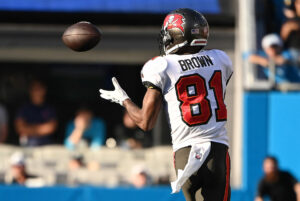
Bucs WR Antonio Brown – Photo by: USA Today
So, let Evans continue dominating on the outside. Use Scotty Miller as the third wide receiver in 11. Putting a deep threat outside on each side of the field creates a bind for the defense. They would have to choose between leaving Evans and Miller in single coverage or letting Brown work one-on-one underneath. Miller obviously has his limitations, and Arians might even choose Breshad Perriman or Cyril Grayson instead, but that’s all fine print for later.
The important thing is that Arians and Leftwich schematically acknowledge the absence of Godwin and re-optimize the offense for their personnel. Few teams have the luxury of replacing their most important receiver with a Hall of Fame talent, and it’s crucial that the Bucs take advantage by maximizing Brown.

